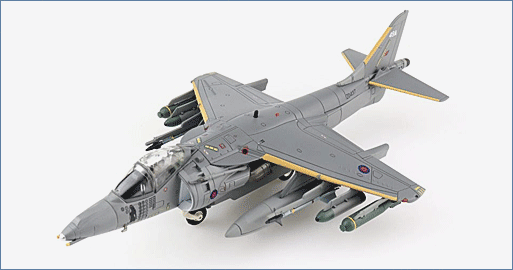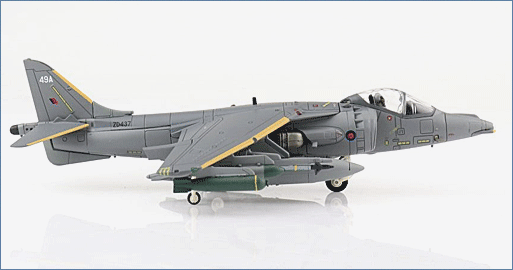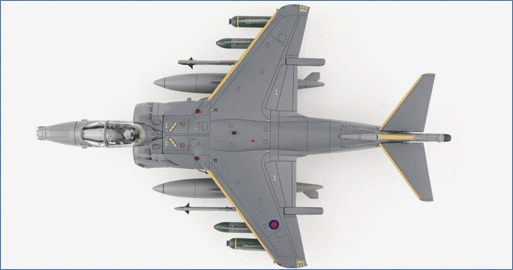Air Power Series>1:72 die-cast display model>Harrier>HA2650
GR.7A Harrier "Michelle" ZD437, 1 Sqn., RAF, Afghanistan 2007




General Background
The Harrier is the first operational V/STOL (Vertical/Short Takeoff and Landing) aircraft. By directing the engines exhaust through movable nozzles the force could be used to propel the aircraft along a runway or lift it vertically and then into a forward motion. Because of this ability to lift off vertically the Harriers began to be referred to as “jump jets”. These aircraft were continuously being refined and improved over the years with many new variants being produced.
The Aircraft
“Operation Herrick” was the British name for their participation in the NATO International Security Assistance Force (ISAF) that took place in Afghanistan from 2002 to 2014 with Harriers joining the operation in 2004 until 2010. The Harriers from the RAF and the RN Fleet Air Arm combined to form Joint Force Harrier (JFH) and flew in pairs in support of British ground forces as well as other NATO troops.
Harrier GR7A ZD404 was named Lucy and ZD437 was named Michelle after a morale boosting visit from The Sun tabloid Page 3 models Lucy Pinder and Michelle Marsh.
Specifications :
| Crew: | 1 |
| Dimensions | |
| Length: | 46 ft 4 in (14.12 m) |
| Height: | 11 ft 8 in (3.56 m) |
| Wingspan: | 30 ft 4 in (9.25 m) |
| Wing area | 343 ft² (22.6 m²) |
| Weights | |
| Empty: | 12,500 lb (5,700 kg) |
| Loaded: | 15,703 lb (7,123 kg) |
| Maximum Takeoff : | VTO 18,950 lb (8,595 kg) |
| STO 31,000 lb (14,016 kg | |
| Powerplant | |
| Engines: | 1× Rolls-Royce Pegasus Mk. 105 turbofan with four thrust vectored exhaust nozzles, 21,750 lb (96.7 kN) |
| Performance | |
| Maximum speed: | 662 mph (1,065 km/h) |
| Combat radius: | 300 nmi (556 km) |
| Ferry range: | 2,015 mi ( 3,242.8 km ) |
| Service ceiling: | 50,000 ft (15,000 m) |
| Rate of climb: | 14,715 ft/min (74.8 m/s) |
| Armament | |
| Guns | 2 × 30 mm (1.18 in) ADEN cannon pods under the fuselage |
| Hardpoints | 8× under-wing pylon stations holding up to 8,000 lb (3,650 kg) of payload |

